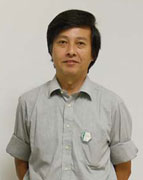Commentary: Youhei Morita
 |
| Photo courtesy of Youhei Morita |
Raised on Manga
When I was a kid, I used to watch animations on TV and read Manga magazines a lot. As you can imagine, my parents were not very enthusiastic about it at all. "Benkyo shinasai!" meaning "Study hard (rather than wasting time on such things)!" was their automatic, second-nature scolding. In fact, there were a whole lot of themes in those Mangas, ranging from entertainment to love, life, art, history, geography, adventures, comedy, and tragedy. Kids of our generation were raised in Manga culture, absorbing lots of lessons in these artificial mini-theaters.
Decades have passed, and Japanese Manga culture is gradually spreading to the world. Dragonball and Pokemon are becoming popular among younger generations of Europeans and Americans. Still, Western journalists in Japan sometimes are amused to see Japanese adults so absorbed in reading Manga magazines on commuter trains. Lots of serious textbooks for training company recruits in economics, law, and customer relations are now being written in Manga style.
Takuya Uruno, whose work appears on the cover of this issue and on page 30, specializes in drawing Manga for companies to use in public relations and for educating recruits. When he first turned up at the KEK campus, he wore samue—down-to-earth, casual, Japanese-style work clothes—and a pair of zohri, sandals made from hand-woven grass stalks, which were quite an unusual sight even at KEK. We discussed the possibility of collaborating on a physics edutainment series, and he instantly jumped on the idea. Though he did not know much about research at KEK, he was enthusiastic about conveying the marvels of the research to the younger generation. We talked for hours about classical and legendary Manga works, comedies, and jokes.
Then I asked him a rather rude question: "Do you wear those clothes even when you meet company executives?" His answer was amusing. He purposefully wears them because people in Japan, especially the older generation, still have a certain kind of stereotyped impression of Manga artists. "It helps my business if my fashion meets their expectations," Uruno said, smiling.
Despite the recent popularity of Japanese Manga culture, he says making a living from Manga is tough: "There is still the old master-and-assistant system in this guild. There are so many young Manga artist wannabes out there, but only one in thousands might get enough earnings from the magazine publishers." He felt he needed to modernize the system for Manga artists, and started his own company that handles corporate Manga works, establishing it as a business.
Uruno becomes serious when he tries to understand the needs and the backgrounds of his clients. His job starts with choosing the right corporate images and characters for his work, and he also reads a lot of documents and background materials about the clients. We have spent almost one year discussing the designs and plots of the new Manga edutainment for KEK. During this period, KEK Professor Makoto Kobayashi shared the Nobel Prize in Physics, and we discussed how to incorporate this big news into the story.
The first chapter of Kasoku Kids appeared on December 26, 2008. Kasoku means "acceleration" in Japanese, and when combined with the first two characters of "kids" in English it becomes kasokuki, meaning "accelerator." We have been publishing chapters at the end of each month since then, and will continue until the final chapter, expected late next year.
The story line involves four kids trying to find a theme for their summer project. In the process, they meet the imaginary Dr. Fujimoto and Dr. Takahashi and start to learn about various aspects of nature and ongoing research at KEK.
The series has gained some popularity among science-fan bloggers. However, the best is yet to come. We are planning a print publication to get more exposure at our annual open house and to circulate materials to other academic activities and so on.
Kids these days seem to be absorbed in instant-communication devices, such as mobile phones and the Internet. One of these days, I may have to shout at my kids, "Manga demo yonde benkyo shinasai!"—study hard by reading Manga!
Youhei Morita is head of communication at KEK, the High Energy Accelerator Research Organization, in Tsukuba, Japan.
Click here to download the pdf version of this article.


